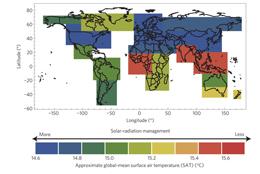Adding aerosols to the atmosphere will not counter global warming in all regions. Attempting to offset global warming by injecting sunlight-reflecting gases into the upper atmosphere isn't the quick fix for global climate change that advocates believe it might be, a new study finds. In a paper published today in Nature Geoscience1, Kate Ricke, a climate physicist at Carnegie Mellon University in Pittsburgh, Pennsylvania, and her colleagues show, by modelling, that not only could solar-radiation management lead to declines in rainfall in the long term, but its effects will also vary by region. Some places will be over-cooled by atmospheric changes that are too small to be effective for their neighbours. The gases under consideration are sulphur compounds that would produce sulphate aerosols in the upper atmosphere. Geoengineering advocates have proposed injecting large quantities of these materials into the stratosphere, either by shooting them up in artillery shells or releasing them from high-flying aeroplanes. Once there, they would disperse into a thin, bright haze that would reflect enough sunlight back into space to partially or completely offset global warming. The goal would be to mimic the effects of volcanoes eruptions such as the 1991 eruption of Mount Pinatubo in the Philippines, which blasted enough sulphates into the stratosphere to temporarily reduce the global temperature by nearly half a degree. Geoengineers propose mimicking this on ever-expanding scales, so that increasing levels of greenhouse gases are offset by ever-greater levels of sunlight reduction. The new study found that it is fairly easy to design sulphate-injection scenarios that keep the temperature stable until 2080. But, unfortunately, the change in sunlight alters other weather patterns. "It changes the distribution of energy in the troposphere so that it becomes more convectively stable," Ricke says. The result: decreasing precipitation. Regional effects are also important. For example, Ricke says, her study found that levels of sulphate that kept China closest to its baseline climate were so high that they made India cold and wet. Those that were best for India caused China to overheat. She notes, however, that both countries fared better either way than under a no-geoengineering policy. The modellers also found that all of these effects get worse with time. "The compensation is imperfect," Ricke says. "The longer you do it, the more imperfect it becomes." Thus, she says, this type of geoengineering is at best a temporary fix — something people working in the field had always known because it does nothing to prevent the accumulation of carbon dioxide and the resulting acidification of the oceans. "But it might be even more temporary than people had expected." Other scientists are impressed. "I think the paper is great," says Ken Caldeira, a climate scientist at the Carnegie Institution for Science's Department of Global Ecology, in Stanford, California. "I offered Kate a postdoc based on these results." Alan Robock, a geophysicist at Rutgers University in New Brunswick, New Jersey, agrees. "It confirms that it is not possible to control both temperature and precipitation using stratospheric geoengineering," he says. The researchers used a global climate model, called HadCM3L, from the Hadley Centre for Climate Prediction and Research in Exeter, UK. To run their simulations, however, they made use ofclimateprediction.net, a climate-forecasting experiment in which thousands of people volunteer to have their home computers do climate simulations when inactive. "This is something that people can sign up for on home computers that sit idle most of the day," Caldeira says. "When the computer notices it is idle for a while, it starts running climate models." Caldeira and Robock are impressed by the use of Climateprediction.net, but Caldeira points out that as the team only used one model, some of Ricke's specific findings, such as the details of the India–China disparity, might be model-specific. "I don't think climate modelling is at the point where we should trust one single model at that scale," Caldeira says. "But I think the results are robust in the sense that it's the kind of issue that people will need to face. The qualitative idea is that you're going to have differential results in different regions, and that's going to cause people to want different amounts of this stuff up there, if they want any of it up there at all." Ricke agrees. "We don't intend these results to give a definitive indication of what's going to happen," she says. "It's more an illustration of the type of regional effect you would see." Geoengineering can't please everyone
 Releasing sulphates from aeroplanes would not ward off the effects of global warming equally well for all regions of the world.iStockphoto
Releasing sulphates from aeroplanes would not ward off the effects of global warming equally well for all regions of the world.iStockphotoTemporary fix
 Click for a larger version of this image.Ricke, K. L., Morgan, M. G. & Allen, M. R. Nature Geosci.
Click for a larger version of this image.Ricke, K. L., Morgan, M. G. & Allen, M. R. Nature Geosci.Cloud computing
“It confirms that it is not possible to control both temperature and precipitation using stratospheric geoengineering.”
Subscribe to:
Post Comments (Atom)






0 comments:
Post a Comment